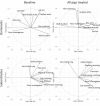Cutaneous application of SecurePig® FLASH, a Pig appeasing pheromone analogue, facilitates adaptation and manages social behavior during feeding in semi-extensive conditions
- PMID: 38444017
- PMCID: PMC10916065
- DOI: 10.1186/s40813-024-00363-z
Cutaneous application of SecurePig® FLASH, a Pig appeasing pheromone analogue, facilitates adaptation and manages social behavior during feeding in semi-extensive conditions
Abstract
Background: Farm animals face several challenges throughout their lives, which can affect both their welfare and their productivity. Promoting adaptation in animals is one way of limiting these consequences. In various animal species, the use of maternal appeasing pheromones is efficient to reduce aggressiveness, improve adaptation and thus ensuring better welfare and productivity. This study sought to investigate the efficiency of a treatment with a Pig Appeasing Pheromone (PAP) on the behavior of pigs reared under semi-extensive conditions and exposed to a potential conflict- collective feeding. Animals (n = 14 divided in 2 groups of 7) were subjected to 3 different phases, (A) baseline - no pigs received the PAP, (B) SP - 2 out of the 7 pigs per group received the PAP and (C) AP- all pigs received the PAP. Behaviors related to feeding, aggression and locomotion were compared between the 3 phases of the study.
Results: Compared to the baseline period, we observed that the number of head knocks was reduced when some pigs (p < 0.001) and all pigs (p < 0.005) received the PAP. Similarly, we observed that the number of fleeing attempts was reduced when some pigs (p < 0.001) and all pigs (p < 0.001) were treated when compared to baseline. This number was lower in the AP phase than in the SP phase (p < 0.001). When all pigs were treated (AP), we also observed that they spent less time investigating the floor than during the two other phases (p < 0.001), but they seemed more likely to leave the feeder due to the presence or behavior of another pig of the group (SP vs. AP, p < 0.05).
Conclusions: The PAP application improved adaptation in pigs by reducing aggressiveness and promoting conflict avoidance. Those results validate the efficiency of the pheromonal treatment under semi-extensive rearing conditions to help pigs to cope with a challenging situation. Using PAP in the pig industry seems interesting to limit unwanted consequences of farm practices on animal welfare and productivity, by promoting their adaptation.
Keywords: Agonistic behavior; Appeasing pheromones; Communal feeding; Coping; Miniature pigs; Outdoor enclosure; Pig welfare.
© 2024. The Author(s).
Conflict of interest statement
The authors declare no competing interests.
Figures



Similar articles
-
Effect of wither application of an analogue of pig appeasing pheromone on encounters between unfamiliar mini-pigs.Porcine Health Manag. 2022 Dec 14;8(1):50. doi: 10.1186/s40813-022-00294-7. Porcine Health Manag. 2022. PMID: 36514149 Free PMC article.
-
Appeasing pheromone inhibits cortisol augmentation and agonistic behaviors during social stress in adult miniature pigs.Zoolog Sci. 2009 Nov;26(11):739-44. doi: 10.2108/zsj.26.739. Zoolog Sci. 2009. PMID: 19877832 Clinical Trial.
-
Preliminary findings on the effect of the pig appeasing pheromone in a slow releasing block on the welfare of pigs at weaning.Porcine Health Manag. 2016 Jun 1;2:13. doi: 10.1186/s40813-016-0030-5. eCollection 2016. Porcine Health Manag. 2016. PMID: 28405439 Free PMC article.
-
Pig pheromones and behaviors: A review.Theriogenology. 2021 Nov;175:1-6. doi: 10.1016/j.theriogenology.2021.08.032. Epub 2021 Aug 27. Theriogenology. 2021. PMID: 34481226 Review.
-
Appeasing Pheromones for the Management of Stress and Aggression during Conservation of Wild Canids: Could the Solution Be Right under Our Nose?Animals (Basel). 2021 May 27;11(6):1574. doi: 10.3390/ani11061574. Animals (Basel). 2021. PMID: 34072227 Free PMC article. Review.
Cited by
-
Helping Rabbits Cope with Veterinary Acts and Vaccine-Related Stress: The Effects of the Rabbit Appeasing Pheromone (RAP).Animals (Basel). 2024 Dec 9;14(23):3549. doi: 10.3390/ani14233549. Animals (Basel). 2024. PMID: 39682514 Free PMC article.
References
-
- Broom DM. Coping, stress and welfare. Coping with Challenge: Welfare in Animals including Humans, Proceedings of Dahlem Conference. Berlin: Dahlem University press; 2001.
-
- Wechsler B. Coping and coping strategies: a behavioural view. Appl Anim Behav Sci. 1995;43:123–34. doi: 10.1016/0168-1591(95)00557-9. - DOI
LinkOut - more resources
Full Text Sources
Research Materials

